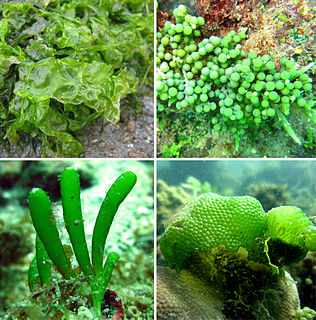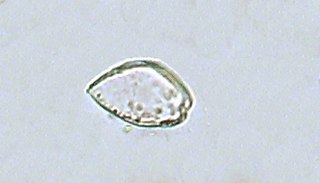
The Ulvophyceae or ulvophytes are a class of green algae, distinguished mainly on the basis of ultrastructural morphology, life cycle and molecular phylogenetic data. The sea lettuce, Ulva, belongs here. Other well-known members include Caulerpa, Codium, Acetabularia, Cladophora, Trentepohlia and Monostroma.

The Prorocentrales are a small order of dinoflagellates. They are distinguished by having their two flagella inserted apically, rather than ventrally as in other groups. One flagellum extends forward and the other circles its base, and there are no flagellar grooves. This arrangement is called desmokont, in contrast to the dinokont arrangement found in other groups. Accordingly, the Prorocentrales may be called desmoflagellates, and in some classifications were treated as a separate class Desmophyceae.

Acetabularia is a genus of green algae in the family Polyphysaceae, Typically found in subtropical waters, Acetabularia is a single-celled organism, but gigantic in size and complex in form, making it an excellent model organism for studying cell biology. In form, the mature Acetabularia resembles the round leaves of a nasturtium, is 0.5 to 10 cm tall and has three anatomical parts: a bottom rhizoid that resembles a set of short roots; a long stalk in the middle; and a top umbrella of branches that may fuse into a cap. Unlike other giant unicellular organisms, which are multinucleate, Acetabularia has a single nucleus, located in the rhizoid and allows the cell to regenerate completely if its cap is removed. The caps of two Acetabularia may also be exchanged, even from two different species. In addition, if a piece of the stem is removed, with no access to the nucleus in the rhizoid, this isolated stem piece will also grow a new cap.

Phacelia crenulata is a species of flowering plant in the borage family, Boraginaceae. Its common names include notch-leaf scorpion-weed, notch-leaved phacelia, cleftleaf wildheliotrope, and heliotrope phacelia. It is native to the southwestern United States as far east as Colorado and New Mexico, and Baja California and Sonora in Mexico.

AlgaeBase is a global species database of information on all groups of algae, as well as one group of flowering plants, the sea-grasses.

Dictyotales is a large order in the brown algae. Members of this order generally prefer warmer waters than other brown algae. One genus in this order is calcareous, Padina, the only calcareous member of this phylum.

Eucalyptus crenulata, commonly known as Buxton gum, silver gum or Victorian silver gum, is a rare species of medium-sized tree that is found only in the wild in a small area in Victoria but is widely planted. It has rough, compacted bark on the trunk, sessile, egg-shaped to heart-shaped leaves arranged in opposite pairs, flower buds covered with a white, powdery bloom, white flowers and cup-shaped fruit.

Leptotes cassius, the Cassius blue or tropical striped blue, is a butterfly of the family Lycaenidae. It is found in North America in Florida including the Keys, Texas south through the Caribbean, Mexico, and Central America to South America. Strays have been found in New Mexico, Kansas, Missouri, South Carolina, North Carolina and Virginia.

Halimeda tuna is a species of calcareous green seaweed in the order Bryopsidales. It is found on reefs in the Atlantic Ocean, the Indo-Pacific region and the Mediterranean Sea. Halimeda tuna is the type species of the genus Halimeda and the type locality is the Mediterranean Sea. The specific name "tuna" comes from the Taíno language, meaning "cactus" and referring to the resemblance of the thallus to the growth form of an Opuntia cactus.

Megathura crenulata is a northeastern Pacific Ocean species of limpet in the family Fissurellidae known commonly as the great keyhole limpet or giant keyhole limpet. Megathura is a monotypic genus, in other words, this is the only species in that genus. This species occurs along the rocky coast of western North America, its distribution extending from Southern California to the Baja California peninsula in Mexico. It is found in the intertidal zone and in the sea up to a depth of 33 meters.

Oxymeris crenulata, common name crenulate auger, is a species of sea snail, a marine gastropod mollusk in the family Terebridae, the auger snails.

Thalassia testudinum, commonly known as turtlegrass, is a species of marine seagrass. It forms meadows in shallow sandy or muddy locations in the Caribbean Sea and the Gulf of Mexico. Turtle grass and other seagrasses form meadows which are important habitats and feeding grounds. The grass is eaten by turtles and herbivorous fish, supports many epiphytes, and provides habitat for juvenile fish and many invertebrate taxa.

The Halmahera naked-backed fruit bat is a common and widespread species of megabat in the family Pteropodidae. It is endemic to Indonesia. It is assessed as least-concern by the IUCN as it has a wide range and seems to have no significant threats.

Acetabularia caliculus, the umbrella alga, is a species of green alga found in shallow temperate and tropical seas. It usually grows on pebbles, shells or pieces of rock, and is often found in seagrass meadows, on mudflats and coral reefs, in estuaries and growing on the submerged roots of mangroves. Each individual thallus consists of a single cell with a long stipe and a terminal cup-shaped or flattened disc.
Alexandrium monilatum is a species of armored, photosynthetic, marine dinoflagellates. It produces toxins that, when present in high concentrations as "red tides", can kill fish and reduce growth rates of shellfish.
Ulva profunda is a species of seaweed in the family Ulvaceae that can be found in US state of Florida, India, and the island of Mauritius.

Acetabularia acetabulum is a species of green alga in the family Polyphysaceae. It is found in the Mediterranean Sea at a depth of one to two metres.

Dictyota is a genus of seaweed in the family Dictyotaceae. Species are predominantly found in tropical and subtropical seas, and are known to contain numerous chemicals (diterpenes) which have potential medicinal value. As at the end of 2017, some 237 different diterpenes had been identified from across the genus.

Amanita crenulata, also known as the poison champagne amanita is a species of fungus that is very common in the Northeast United States.















